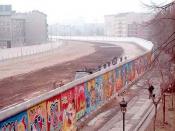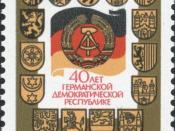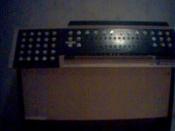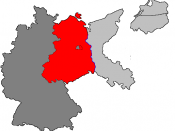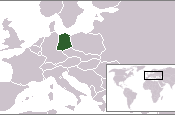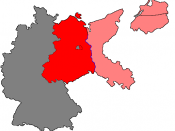The first division of Germany was planned by the victorious Allies, which consisted of the United States, the Soviet Union and Great Britain. Vladimir Llich Lenin, the Russian founder of the Bolsheviks and leader of the Russian Revolution, stated that whoever controls Berlin controls Germany and whoever controls Germany controls Europe (Grass 29). This suspicion alarmed the Allies, including President Harry Truman of the United States. Truman objected to their imposition of Communist rule in part of liberated East Europe.
To this extent, despite Truman's concerns, the Allies agreed to give most of the Eastern Germany to Poland and the Soviet Union. With the remaining sectors of Germany, the Allies then would divide the rest into four zones of occupation. The city was surrounded by the German Democratic Republic (GDR), which was East Germany, and was partitioned into East Berlin and West Berlin. Berlin was in the Soviet sector of the post war division.
East Germany, under the Communist influence and with East Berlin as its capital, did not prosper as intended as West Germany did. To this outcome, German people of East Germany despised the Soviet Union for their influences and for their intentions to run a government.
The angered people, despite the warnings posted along the divided line, went on with their daily routine. The people crossed the line to visit relatives and friends, going shopping, attending work, and going to theatres. This action angered the Soviets and so they proposed to shield its people from the attractions of West Germany. "The East German regime lowered an Iron Curtain along the 858-mile border between the two German states"ÃÂ (Epler 45). Because of the dissatisfaction of the economic progress and the political conditions, an increasing number of people left the German Democratic Republic. In reaction, the Soviets, under Prime Minister Nikita Khrushchev, delivered the Berlin Ulimatum, demanding that the western allies should withdraw their troops from West Berlin and that West Berlin should become a free city within six months (Ramm). In response, a meeting was held on February 17, 1959, between President Kennedy and Prime Minister Khrushchev in Vienna. The conference, however, ended without any results.
The East German government had only one intention of preventing the people from leaving the German Democratic Republic. At an international press conference on June 15, 1961, Walter Ulbricht, the leader of the East German communist party, or SED, and President of the Privy Council announced people in West Germany wanted to mobilize the contraction workers of the German Democratic Republic to construct a wall. This announcement was an example of their determination towards their aspirations to continue their influences.
Early in the morning of Sunday, August 13, 1961, the German Democratic Republic began under the discretion of Erich Hunecker to block East Berlin and the German Democratic Republic from West Berlin by means of barbed wiring and antitank obstacles. Streets were mutilated and barricades of stone were constructed. Tanks gathered at crucial places along the two cities. The subway and local railway services between East and West Berlin were interrupted. Inhabitants of East Berlin and the German Democratic Republic were no longer allowed to enter West Berlin.
In the following days of the construction, they replaced the brigades with a solid wall. The Western Allies showed little reaction, they showed more reaction during the blockade of 1947 to 1949.
